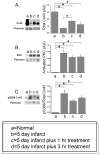Characterization of gap junction remodeling in epicardial border zone of healing canine infarcts and electrophysiological effects of partial reversal by rotigaptide
- PMID: 21493965
- PMCID: PMC3116056
- DOI: 10.1161/CIRCEP.110.959312
Characterization of gap junction remodeling in epicardial border zone of healing canine infarcts and electrophysiological effects of partial reversal by rotigaptide
Abstract
Background: The border zone of healing myocardial infarcts is an arrhythmogenic substrate, partly the result of structural and functional remodeling of the ventricular gap junction protein, Connexin43 (Cx43). Cx43 in arrhythmogenic substrates is a potential target for antiarrhythmic therapy.
Methods and results: We characterized Cx43 remodeling in the epicardial border zone (EBZ) of healing canine infarcts 5 days after coronary occlusion and examined whether the gap junction-specific agent rotigaptide could reverse it. Cx43 remodeling in the EBZ was characterized by a decrease in Cx43 protein, lateralization, and increased Cx43 phosphorylation at serine (S) 368. Rotigaptide partially reversed the loss of Cx43 but did not affect the increase in S368 phosphorylation, nor did it reverse Cx43 lateralization. Rotigaptide did not prevent conduction slowing in the EBZ, nor did it decrease the induction of sustained ventricular tachycardia by programmed stimulation, although it did decrease the EBZ effective refractory period.
Conclusions: We conclude that partial reversal of Cx43 remodeling in healing infarct border zone may not be sufficient to restore normal conduction or prevent arrhythmias.
Conflict of interest statement
Figures






Similar articles
-
Disturbed connexin43 gap junction distribution correlates with the location of reentrant circuits in the epicardial border zone of healing canine infarcts that cause ventricular tachycardia.Circulation. 1997 Feb 18;95(4):988-96. doi: 10.1161/01.cir.95.4.988. Circulation. 1997. PMID: 9054762
-
Heterogeneous gap junction remodeling in reentrant circuits in the epicardial border zone of the healing canine infarct.Cardiovasc Res. 2006 Nov 1;72(2):241-9. doi: 10.1016/j.cardiores.2006.07.005. Epub 2006 Jul 12. Cardiovasc Res. 2006. PMID: 16914125
-
Model-dependent effects of the gap junction conduction-enhancing antiarrhythmic peptide rotigaptide (ZP123) on experimental atrial fibrillation in dogs.Circulation. 2007 Jan 23;115(3):310-8. doi: 10.1161/CIRCULATIONAHA.106.665547. Epub 2007 Jan 15. Circulation. 2007. PMID: 17224477
-
Pharmacological modulation of gap junction function with the novel compound rotigaptide: a promising new principle for prevention of arrhythmias.Basic Clin Pharmacol Toxicol. 2007 Oct;101(4):215-30. doi: 10.1111/j.1742-7843.2007.00123.x. Basic Clin Pharmacol Toxicol. 2007. PMID: 17845503 Review.
-
Improving cardiac gap junction communication as a new antiarrhythmic mechanism: the action of antiarrhythmic peptides.Naunyn Schmiedebergs Arch Pharmacol. 2010 Mar;381(3):221-34. doi: 10.1007/s00210-009-0473-1. Epub 2009 Nov 27. Naunyn Schmiedebergs Arch Pharmacol. 2010. PMID: 19943035 Review.
Cited by
-
Cardiomyocyte ATP release through pannexin 1 aids in early fibroblast activation.Am J Physiol Heart Circ Physiol. 2012 Nov 15;303(10):H1208-18. doi: 10.1152/ajpheart.00251.2012. Epub 2012 Sep 14. Am J Physiol Heart Circ Physiol. 2012. PMID: 22982782 Free PMC article.
-
Connexin 43 hemichannels and related diseases.Antib Ther. 2024 Nov 11;7(4):361-369. doi: 10.1093/abt/tbae024. eCollection 2024 Oct. Antib Ther. 2024. PMID: 39678258 Free PMC article. Review.
-
Post translational modifications of connexin 43 in ventricular arrhythmias after myocardial infarction.Mol Biol Rep. 2024 Feb 23;51(1):329. doi: 10.1007/s11033-024-09290-2. Mol Biol Rep. 2024. PMID: 38393658 Review.
-
Evaluation of Tyrosine Kinase Inhibitors Loaded Injectable Hydrogels for Improving Connexin43 Gap Junction Intercellular Communication.ACS Appl Mater Interfaces. 2024 Jan 17;16(2):1985-1998. doi: 10.1021/acsami.3c10923. Epub 2024 Jan 4. ACS Appl Mater Interfaces. 2024. PMID: 38175743 Free PMC article.
-
Myofibroblasts cause heterogeneous Cx43 reduction and are unlikely to be coupled to myocytes in the healing canine infarct.Am J Physiol Heart Circ Physiol. 2012 Feb 1;302(3):H790-800. doi: 10.1152/ajpheart.00498.2011. Epub 2011 Nov 18. Am J Physiol Heart Circ Physiol. 2012. PMID: 22101526 Free PMC article.
References
-
- Dillon S, Allessie M, Ursell PC, Wit AL. Influence of anisotropic tissue structure on reentrant circuits in the subepicardial border zone of subacute canine infarcts. Circulation Research. 1988;63:182–206. - PubMed
-
- Peters NS, Coromilas J, Severs NJ, Wit AL. Disturbed connexin43 gap junction distribution correlates with the location of reentrant circuits in the epicardial border zone of healing canine infarcts that cause ventricular tachycardia. Circulation. 1997;95:988–996. - PubMed
Publication types
MeSH terms
Substances
Grants and funding
LinkOut - more resources
Full Text Sources
Medical
Miscellaneous

